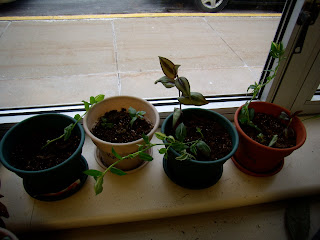
Today we had a visitor from C.O.D. Miss Britt is the manager at the greenhouses there. She brought a HUGE verigated spider plant with her. Verigated means it is different from the original plant. Most plants, when they first start out, are all green. When they get sick, they can get streaks of white in them. When this happens, growers may try to make more of them because the leaf is pretty. We learned that plants like this or with lighter colored leaves need more sunlight, or they'll turn back to mostly green!

Then we went outside to look at our gardens with her. She showed us a poke weed that was covered in baby aphids. Aphids are mean little bugs that eat plants and kill them. We also learned that bees eat aphids! We didn't know that! We learned that bugs like aphids can survive through the winter, sort of like hibernating. When they wake up in the spring they can start eating all our good plants! This is not good news. So we're going to pull that weed and throw it and all the baby aphids away.

Miss Britt also told us how to move the tall grasses in front of the 3rd grade classroom windows. We'll have to wait until March or April, before they start to regrow for the spring. Then we'll have to dig them up and plant them somewhere else. Then she gave us some suggestions for what to plant in our outdoor classroom that will survive the shade, be pretty and cover up the beds. Finally we looked at our hosta garden. She had some good ideas on how to prevent thistles from growing there in the spring. Hopefully we'll get to try them out.
We're going to go tour C.O.D. green houses in 2 weeks! We are really looking forward to that!















